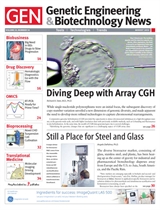Oct 17 2013
In the October 16th issue of Science Translational Medicine, Xiao-jun Li of Seattle's Integrated Diagnostics (Indi) along with colleagues at the Institute for Systems Biology, Seattle; the British Columbia Cancer Agency, Vancouver; Vanderbilt University Medical Center; New York University Langone Medical Center; and the University of Pennsylvania reported that they had developed a 13-protein blood-based classifier that differentiates malignant and benign lung nodules.
Only about 20% of patients with lung nodules undergoing needle or surgical biopsies actually have a malignant lung nodule. Therefore, many patients with benign nodules undergo unnecessary invasive procedures. The laboratory-based blood test measures protein expression to differentiate between benign lung nodules and early-stage cancer without the need for an invasive test.
The development of Indi's test involved the use of multiple reaction-monitoring mass spectroscopy (MRM-mass spec) combined with bioinformatics and systems biology. This combination of technologies allowed the researchers to assess the diagnostic power of 371 potential lung cancer biomarkers in millions of different combinations before settling on the diagnostic classifier (set of biomarkers) that these data indicate is most effective, identifying 13 blood proteins that could reliably differentiate between benign lung nodules and early-stage lung cancer.
Key to the successful development of the test was the removal of highly abundant and irrelevant proteins from blood samples prior to mass spec detection and quantitation of the 13 key informative proteins. This was accomplished using protein depletion technology from Sigma-Aldrich (Seppro® IgY14 and Human SuperMix protein depletion technology).
Aaron Sin, Ph.D., S-A Global Product Marketing Manager, said, "The most disease-relevant proteins are also the rarest, comprising less than 2% of proteins in plasma or serum. The most advanced mass spectrometers are blind to these rare proteins, that is, unless the other 98% of proteins are removed."
He further commented that while typical approaches eliminate the top ten or so high-abundance proteins, there are tens to hundreds more medium-abundance proteins that still overwhelm the mass spectrometer and prevent the reliable detection of the most valuable proteins of relevance to human health. Sigma's approach depletes 50–200 medium abundance proteins, in addition to the standard top ~14 proteins.
The test and the development of the test used analyses of proteins found circulating in blood below the 10 ng/mL level, the "previous sensitivity/reliability cliff for protein biomarker analysis by mass spec." The chemical/biology company Sigma-Aldrich provided a unique protein depletion technology to enable that and will supply the reagent to Indi's CLIA-certified test.
The study results suggest that when this group of proteins (or "classifier") is detected, and their relative concentrations are used to identify a patient's lung nodule (a round lesion of up to three cm) as benign, the classifier result is correct more than 90 percent of the time. The findings hint that a blood test that detects these 13 proteins may help doctors determine nodules that do not require risky and costly clinical interventions.
This study was published in the October 16th issue of Science Translational Medicine under the title, "A Blood-Based Proteomic Classifier for the Molecular Characterization of Pulmonary Nodules."

 This article was reprinted from Genetic Engineering & Biotechnology News (GEN) with permission from Mary Ann Liebert, Inc., publishers. Genetic Engineering & Biotechnology News (GEN) has retained its position as the number one biotech publisher around the globe since its launch in 1981. GEN publishes a print edition 21 times a year and has additional exclusive editorial content online, like news and analysis as well as blogs, podcasts, webinars, polls, videos, and application notes. GEN's unique news and technology focus includes the entire bioproduct life cycle from early-stage R&D, to applied research including omics, biomarkers, as well as diagnostics, to bioprocessing and commercialization.
This article was reprinted from Genetic Engineering & Biotechnology News (GEN) with permission from Mary Ann Liebert, Inc., publishers. Genetic Engineering & Biotechnology News (GEN) has retained its position as the number one biotech publisher around the globe since its launch in 1981. GEN publishes a print edition 21 times a year and has additional exclusive editorial content online, like news and analysis as well as blogs, podcasts, webinars, polls, videos, and application notes. GEN's unique news and technology focus includes the entire bioproduct life cycle from early-stage R&D, to applied research including omics, biomarkers, as well as diagnostics, to bioprocessing and commercialization.